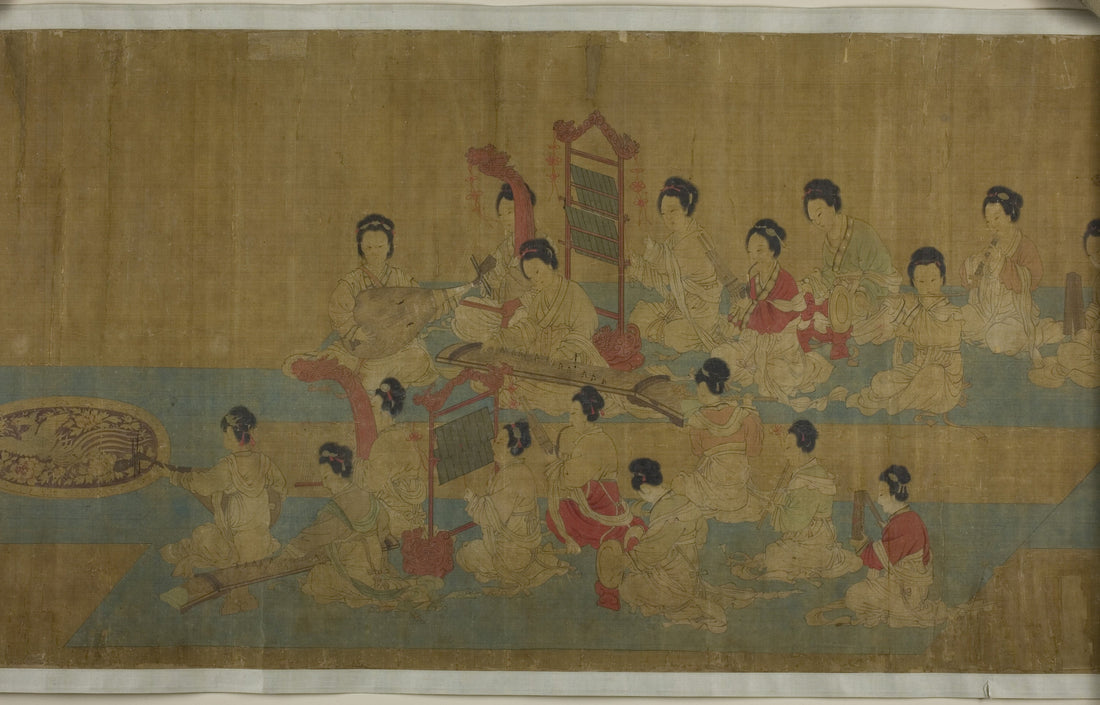
All You Need To Know About the “United By Music” Chinese Artwork
Share
The Ensemble That Played in Silence
Words By Qiao Wen, Heritage Advisor of Tang Heritage
Some paintings do not simply depict music—they let you feel its quiet presence. United By Music (合乐图), attributed to Zhou Wenju, is one such scroll. When I first viewed it in the archives of the Art Institute of Chicago, I did not expect to linger. But the longer I looked, the more it became impossible to leave. It was not the colours, nor the composition, but the mood—a harmony shared by women who needed no audience.
There they sat, arranged in rhythmic grace, each holding an instrument: pipa, konghou, sheng, bamboo flute. The room fell away. Their music, though silent on the silk, felt as if it continued through time—across dynasties, across centuries—until it reached me.
When the Court Played as One
Zhou Wenju was known for his refined depictions of court life, and this scroll remains one of his most celebrated works. In it, an all-female ensemble gathers on a soft blue mat, dressed in elegant robes, playing in quiet unison.
What struck me most was not the detail, but the space between figures—the breath between notes. Each woman leans in just slightly, connected not only by music but by shared awareness. Their instruments vary, but their focus is unified. This is not a scene of performance. It is a study in attentiveness, in presence, in the dignity of cultivated stillness.
A Moment Preserved
Today, the scroll is held by the Art Institute of Chicago. It is painted in ink and colour on silk, rendered in the meticulous gongbi style. The work stretches just under two metres, but it feels expansive.
I remember viewing the high-resolution image for the first time in winter, when the world outside was quiet. I enlarged each corner of the scroll, slowly. A pipa held in mid-note. A guqin angled just so. The soft creases in flowing robes. Even through the screen, the painting held its breath. And in that moment, I found myself doing the same.
From Scroll to Silk
When we brought this painting into Tang Heritage’s scarf collection, I thought carefully about how to preserve its rhythm.
The original, though exquisite, had softened over time. The pigments had faded into a gentle palette of beige, rust, and grey-blue. But silk demands clarity. On the body, the artwork would move—it would fold, wrap, reflect light. And so we adapted with intention.
The blue mat beneath the women was deepened slightly, to hold the composition steady. The robes were lifted with warmer undertones—not to modernise, but to honour the richness that might once have been. A soft frame was introduced, giving the scarf balance and finish.
It is not a reproduction. It is a revival.
To wear it is to join the ensemble—not as a viewer, but as part of the music.
Let the Ensemble Play On
The United by Music scarf invites you into a shared stillness, where harmony is felt, not heard.
https://tangheritage.com/products/scene-of-harmonious-music-heritage-artwork-silk-scarf
Crafted in limited numbers. A Tang court, carried in silk—its music yours to wear.
